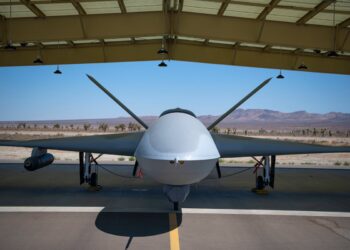An experimental DARPA plane, designated the X-65, is set to have its first flight in late 2027, which is more than two years later than initially scheduled. This delay follows a pause and restructuring of the program due to technical challenges and increased costs.
The X-65, an unmanned aircraft being developed by Boeing subsidiary Aurora Flight Sciences, is part of DARPA’s Control of Revolutionary Aircraft with Novel Effectors (CRANE) program. This aircraft is designed to implement a concept known as “active flow control,” steering without mechanical flaps or rudders, but rather through small bursts of air that manipulate airflow over the wings to adjust the plane’s movements.
In January 2023, DARPA awarded Auror Flight Sciences a $42 million contract for the detailed design of the aircraft utilizing active flow control technology. Aurora, located in Manassas, Virginia, specializes in creating advanced innovative designs for aircraft and uncrewed systems.
The program successfully completed a critical design review in late 2023 and entered its third phase, during which Aurora was contracted to construct a full-scale experimental prototype to test the new technology. In January 2024, it was announced that fabrication of the demonstrator was already underway at Aurora’s facilities in West Virginia and Mississippi, with expectations to commence flight tests in summer of 2024. The aircraft is projected to have a wingspan of 30 feet, a weight of 7,000 pounds, and the capability to achieve speeds up to Mach 0.7 (over 500 miles per hour).
However, the program faced difficulties as production costs for the prototype exceeded initial estimates, leading DARPA to temporarily pause development and reevaluate the project. A partnership was subsequently formed with Aurora in August 2024, making Aurora a co-investor in the X-65 project, ensuring that DARPA’s objectives for CRANE could still be fulfilled.
Despite these setbacks, the structured partnership aims to make costs more manageable for the government. Aurora expects to complete the fuselage of the X-65 by January 2026, followed by further integration work and ground testing anticipated to start in late 2026 or early 2027. Flight tests are currently planned for late 2027, which reflects the risks involved with DARPA projects and challenges within technical and supply chains.
Aurora has committed resources to ensure the completion of the prototype, with adequate funding being provided by both Aurora and DARPA to support integrated ground testing and the first flight. Financial documents indicate that DARPA allocated $38.3 million for CRANE in fiscal 2024, followed by $23.9 million in fiscal 2025, and another $4 million for fiscal 2026.
The X-65, which is being built in Bridgeport, West Virginia, is designed with 14 effectors across its flying surfaces to achieve the necessary air bursts for control. Aurora’s vice president of aircraft development, Larry Wirsing, expressed enthusiasm for the continued partnership with DARPA, highlighting that the X-65 will serve as a valuable asset for future flight testing and innovative aircraft designs facilitated by the underlying technologies and data generated through the program.
In summary, the X-65’s development involves significant investment, strategic partnerships, and a vision of transforming aircraft design through innovative flow control technologies, with its first flight now projected for late 2027.













